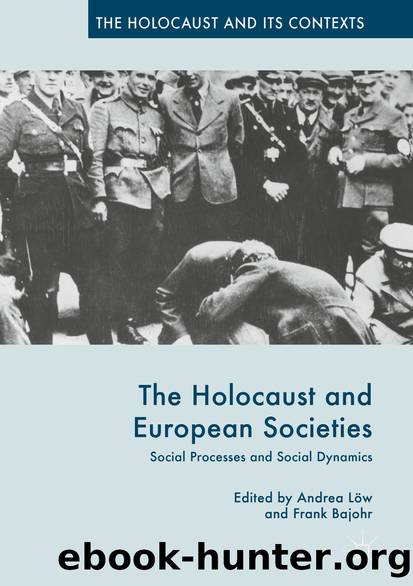The Holocaust and European Societies by Frank Bajohr & Andrea Löw

Author:Frank Bajohr & Andrea Löw
Language: eng
Format: epub
Publisher: Palgrave Macmillan UK, London
Perpetrators and Beneficiaries
In this escalating persecution several perpetrators and beneficiaries stand out: the state, its protagonists, the Slovak majority population and ethnic Germans.
The HSĽS had called for the expropriation of the Jews even before 1938 and, in February 1939, Mach was already saying: âThe Jews, who have gold, jewellery and wealth, they have got rid of everywhere, and we will do so, too. ⦠People, who have stolen wealth here, will have it taken from them. Thatâs the practical solution to the entire Jewish question!â 35 Contrary to Alyâs thesis of governments creating loyal populations by providing them with Jewish property, 36 most of the Jewish property did not go to the âpoor Slovakâ but rather to the state and its institutions, even when there were other intentionsâsince Tiso understood the expropriations âas a way to build a Slovak middle classâ. 37 The state, for example, seized all the assets of the deportees by enacting a Constitutional Law in May 1942, which legalized the deportation and de-naturalization of the deportees retrospectively. 38 The Ministry of Finance finished the main expropriation process in the autumn of 1942 with the transfer of capital, shares, precious metals and diamonds to the Slovak banks. The distribution of looted property among the population was not finished till 1945. 39
The Central Economic Office (CEO) decided whether an enterprise had to be liquidated or be given to a Christian Slovak. Its whole activity was characterized by lack of state control, biased decisions, the growing influence of the party in power and chaotic management. 40 Corruption was rife amongst politicians, a notable example being AugustÃn Morávek, who added to his wealth enormously. The Jewish underground movement âWorking Groupâ was able to bribe Anton VaÅ¡ek, head of the Fourteenth Department, though its bid to get him to slow down the deportations ultimately failed. The Catholic bishopric of SpiÅ¡, represented by its bishop Ján Vojtaššák, applied for the Baldovce Spa, expropriated from its Jewish owner, Ladislav Fried, and obtained it. 41 Tiso himself supplied his family with looted wealth from Jews. 42
Some examples may serve to illustrate how ministries and government institutions cooperated with the CEO. The Ministry of Foreign Affairs contacted it on how to expropriate Slovak Jews abroad. The Central Employment Bureau initiated protests against the employment of Jews. The secret police and the police departments, as well as their community offices, sent in notifications on Jews who had not registered valuables, or who were working without work permits. And people in government authorities and ministries wrote in to request that confiscated Jewish properties (often apartments and houses) should be personally assigned to them. 43
Propaganda had raised a lot of expectations within Slovak society. Up to the end of 1941, 10,000 of the 12,000 enterprises belonging to Jews were liquidated, and the Jewsâ exclusion from economic life was to a large extent achieved. In addition, some âinconvenient competitionâ for non-Jews was removed. About 2,000 of the enterprises seized from Jews were given to non-Jewish applicants. 44 There were
Download
This site does not store any files on its server. We only index and link to content provided by other sites. Please contact the content providers to delete copyright contents if any and email us, we'll remove relevant links or contents immediately.
The Third Pole by Mark Synnott(914)
Money for Nothing by Thomas Levenson(898)
The Economist (20210109) by calibre(897)
Christian Ethics by Wilkens Steve;(824)
Made in China by Anna Qu(812)
The Age of Louis XIV: The Story of Civilization by Will Durant(788)
Reopening Muslim Minds by Mustafa Akyol(768)
Nonstate Warfare by Stephen Biddle(766)
100 Posters That Changed The World by Salter Colin T.;(751)
Culture by Terry Eagleton(724)
The Shortest History of China by Linda Jaivin(722)
The Great Pyramid Void Enigma by Scott Creighton(721)
The Irish Buddhist by Alicia Turner(718)
Ideology by Eagleton Terry;(696)
Routledge Handbook of Contemporary India by Knut A. Jacobsen(694)
Sybille Bedford by Selina Hastings(656)
The Jews of Silence: A Personal Report on Soviet Jewry by Elie Wiesel(651)
Objects of Vision by Saab A. Joan;(639)
Banaras: CITY OF LIGHT by Diana L. Eck(631)
